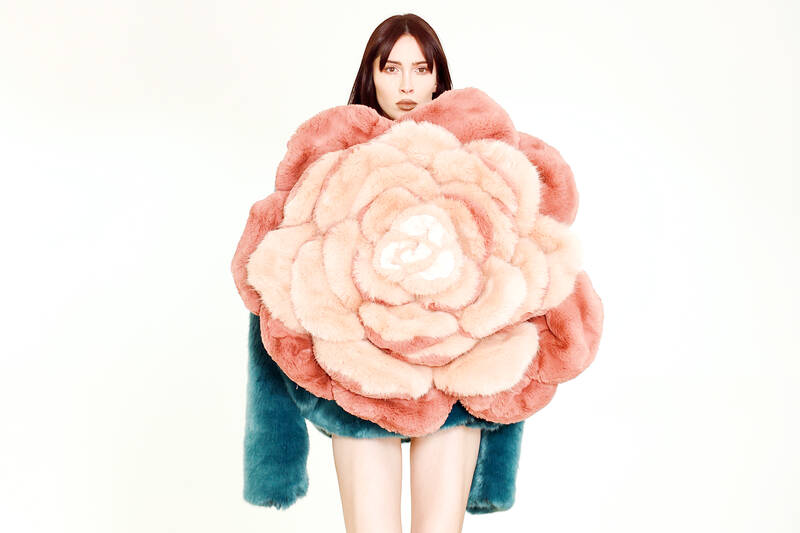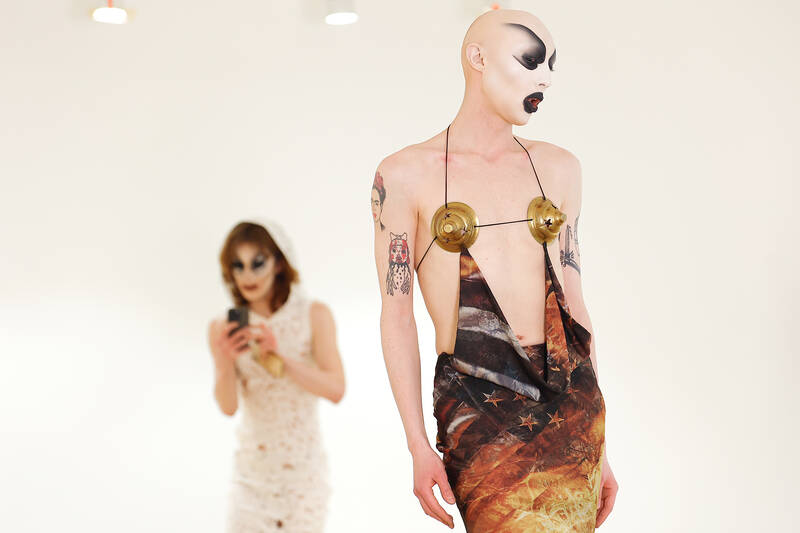Paris Women’s Fashion Week kicked off on Monday with young new labels dominating the catwalks before a trio of hotly awaited designer debuts at Givenchy, Dries Van Noten and Tom Ford in the coming days.
The opening of the world’s biggest fashion week also saw demonstrations from the People for the Ethical Treatment of Animals (PETA) charity and the Brigitte Bardot Foundation to demand the industry stop using animal hides.
Dressed in fake prehistoric fur outfits, five PETA activists held up placards reading “Leave The Stone Age” in front of the French Fashion Institute, while the Brigitte Bardot Foundation sent billboards on trucks denouncing the use of animals for fashion around the City of Light. Fur and sheepskin jackets are back in fashion, with experts like Simon Longland, director of fashion buying at Harrods in London, saying the shearling coat is “set to be the ultimate wardrobe investment” for Fall-Winter 2025.

Photo: EPA-EFE
“We’re here to demand that Paris joins London, Copenhagen and Amsterdam too in banning the use of fur on their catwalks,” PETA spokeswoman Natasha Garnier said.
On the runways, France’s Victor Weinsanto, Japanese label CFCL and New York’s Vaquera held their shows Monday before the bigger corporate luxury jugganauts unveil their Fall-Winter collections later this week. Japanese designer Yusuke Takahashi, who founded CFCL (Clothing For Contemporary Life) just under five years ago, sent out models in knitwear outfits in primary colors, inspired partly by furniture from the 1980s. There was no fur or animal hide in sight, with Takahashi making elaborate use of his favorite material, recycled polyester, which was used for 90 percent of the collection.
“We really focused on knit technology and making new products,” he told reporters afterwards.

Photo: AFP
Victor Weinsanto, an up-and-coming designer from eastern France, stressed that he only used fake leather and fur in his collection in mostly neutral wintery colours of white, beige and black, with a splash of 1980s-style shade of purple.
DEBUTS
Over the next eight days, more than 100 fashion houses will unveil their Fall-Winter 2025-2026 collections, hoping to rally sales in what is an increasingly difficult global luxury market.

Photo: EPA-EFE
Among the most anticipated will be Sarah Burton’s debut at Givenchy on Friday, with the French label given a boost by Hollywood star Timothee Chalamet, who wore a yellow Givenchy suit at the Oscars ceremony at the weekend.
Burton, a 51-year-old Briton who made her name as creative director at Alexander McQueen, was appointed to Givenchy in September.
“Givenchy has a very beautiful history,” she told Vogue in a profile last month. “It appeals to me because it’s a small house, and it’s in Paris.”
Burton is one of a number of recent changes at major brands, with Belgian veteran Dries Van Noten stepping down from his eponymous label last year and handing the reins to fellow countryman Julian Klausner, 33.
Klausner’s first collection on Wednesday will be closely scrutinized. The French Haute Couture and Fashion Federation has also pulled off a coup by luring Tom Ford, a mainstay of New York Fashion Week, to Paris for the first time.
Chief designer Haider Ackermann, in the top job at Tom Ford since September and also tasked with leading a brand defined by its founder, will also be making his catwalk debut on Wednesday.
DOWNTURN
French luxury heavyweights Louis Vuitton, Dior, Saint Laurent and Chanel will produce the biggest budget shows this week, with their front row seats fought over by celebrities and influencers. Dior’s show on Tuesday could be the last from head designer Maria Grazia Chiuri, with persistent rumors and press reports that she is on the way out. Northern Irish stylist Jonathan Anderson, who is currently at the helm of Spanish label Loewe, is tipped as her potential replacement.
The luxury industry as a whole has seen profits fall and sales slow.
Paris-based LVMH, Europe’s largest company by market value, reported a 17 percent fall in annual net profits which it attributed to the end of the luxury-buying “euphoria” following the COVID-19 pandemic.
Analysts see weakness in the key luxury market of China, reduced appetite for high-priced goods, and widespread economic uncertainty as other reasons for the decline.
Fellow French luxury giant Kering reported a 62 percent drop in profits last year, largely due to struggles at its flagship Gucci brand. Elsewhere on Monday, the Financial Times reported that Prada had emerged as the frontrunner to buy fellow Italian label Versace from Capri Holdings for about 1.5 billion euros (US$1.6 billion).
The takeover would combine two of Italy’s best-known luxury fashion brands.

Taiwan can often feel woefully behind on global trends, from fashion to food, and influences can sometimes feel like the last on the metaphorical bandwagon. In the West, suddenly every burger is being smashed and honey has become “hot” and we’re all drinking orange wine. But it took a good while for a smash burger in Taipei to come across my radar. For the uninitiated, a smash burger is, well, a normal burger patty but smashed flat. Originally, I didn’t understand. Surely the best part of a burger is the thick patty with all the juiciness of the beef, the

The ultimate goal of the Chinese Communist Party (CCP) is the total and overwhelming domination of everything within the sphere of what it considers China and deems as theirs. All decision-making by the CCP must be understood through that lens. Any decision made is to entrench — or ideally expand that power. They are fiercely hostile to anything that weakens or compromises their control of “China.” By design, they will stop at nothing to ensure that there is no distinction between the CCP and the Chinese nation, people, culture, civilization, religion, economy, property, military or government — they are all subsidiary

Nov.10 to Nov.16 As he moved a large stone that had fallen from a truck near his field, 65-year-old Lin Yuan (林淵) felt a sudden urge. He fetched his tools and began to carve. The recently retired farmer had been feeling restless after a lifetime of hard labor in Yuchi Township (魚池), Nantou County. His first piece, Stone Fairy Maiden (石仙姑), completed in 1977, was reportedly a representation of his late wife. This version of how Lin began his late-life art career is recorded in Nantou County historian Teng Hsiang-yang’s (鄧相揚) 2009 biography of him. His expressive work eventually caught the attention

This year’s Miss Universe in Thailand has been marred by ugly drama, with allegations of an insult to a beauty queen’s intellect, a walkout by pageant contestants and a tearful tantrum by the host. More than 120 women from across the world have gathered in Thailand, vying to be crowned Miss Universe in a contest considered one of the “big four” of global beauty pageants. But the runup has been dominated by the off-stage antics of the coiffed contestants and their Thai hosts, escalating into a feminist firestorm drawing the attention of Mexico’s president. On Tuesday, Mexican delegate Fatima Bosch staged a